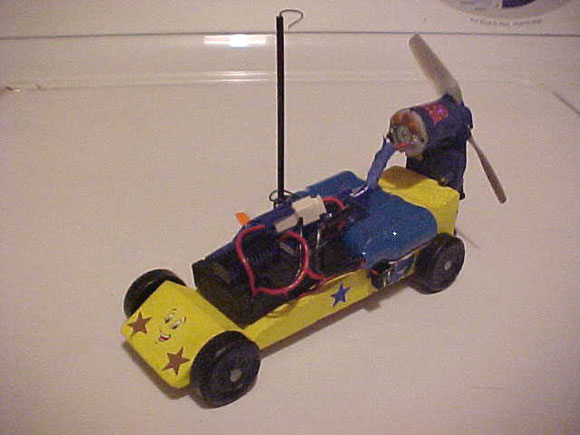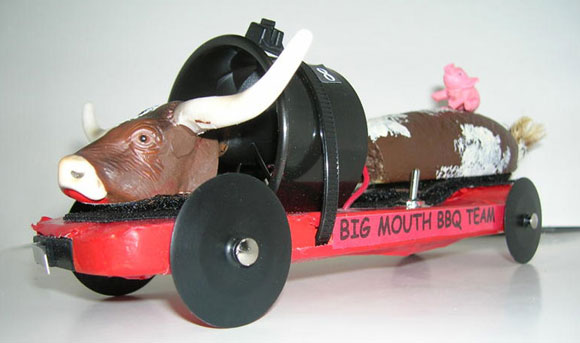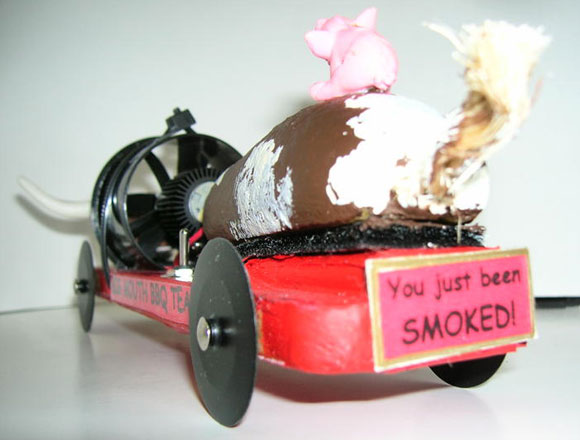– Feature Article – Don’t Do That: Avoiding Pinewood Derby Pitfalls
– Shop Talk – Keep It Square
– Pinewood Derby Car Showcase
– Q&A
Don’t Do That: Avoiding Pinewood Derby Pitfalls
(An update of an article originally published Volume 3, Issue 10 – February 4, 2004)
As I have read information on Pinewood Derby racing, and have talked to derby novices and experts, I occasionally find a gem of information. These I quickly jot down, and then include in this newsletter or in our speed tip booklet (Speed to the Finish). But sometimes, I encounter techniques that make me want to cringe. When I’m on the phone and someone is explaining how they are implementing a bogus speed tip I want to say: “Don’t do that.” Usually I bite my tongue and gently try to explain an alternate technique.
Today’s article includes a list of techniques and products that I counsel you to avoid. Let me make sure this is clear: this is a list of techniques/products that you DO NOT want to implement/use.
General
Rules – First and foremost, ignoring or not understanding the rules for your local race is an absolute no-no. One of the most heartbreaking things I have experienced is explaining to a child that their car violates the rules and therefore cannot run in the race (without being corrected). Remember, ignorance of the law is not an excuse.
Not understanding the local rules for your race before designing and building your car is a recipe for heartbreak.
Car Body
Melted Lead – Melting lead is a traditional way of adding weight to pinewood derby cars. However, it is a practice that comes with health risks. Not only is there a great risk of a serious burn, but lead fumes are toxic. In addition, molten lead will burn wood, and spoil a nice paint job. Instead, insert solid lead (or tungsten) into holes or pockets in the car, using a hammer to shape the lead as needed. Of course anytime you use lead, practice safe handling.
Melted lead can lead to burns and lead poisoning, not to mention damaged cars.
Backwards Car – On many car kits, including those offered by BSA and PineCar, one of the axle slots is positioned closer to the end of the block. Contrary to the picture on the BSA box, the axle slot closest to the end of the block should be used as the rear axle. This allows for a more aggressive balance point, leading to more speed.
Orienting the block backwards will lead to slower performance.
Excessive Rear Weighting – For most tracks, the ballast weight of the car should be placed towards the rear of the car. A reasonable goal is for the completed car to balance at about one inch in front of the rear axle. It is possible to use a more aggressive balance point and gain more speed, but with a great risk of instability. To successfully run with a balance less than one inch requires careful weight placement (usually offset), trued wheels, very accurate alignment (using the rail-riding technique), and access to a track for testing and tuning the car. Because of these requirements, the average car builder that tries to use a very aggressive balance will end up with an unstable car.
A very aggressive balance point will often lead to less performance.
Wheel Treatments
Wafer Thin Wheels – If allowed by the local rules, wheels can be narrowed to improve speed. But it is not the narrowness itself that is beneficial. Instead, the benefit comes from reducing the weight of the wheels. Basically, the lighter the wheels, the faster the car starts. However, there is a limit to the benefit of narrowing wheels. If the hub is left full length, then the wheel will no longer stand upright. Thus, when attached to the car, the wheel will tilt towards the car. This tilting causes the axle and wheel hub to bind, reducing the speed of the car. In addition, the narrow wheels and full-length hub will lead to more free-play around the center guide rail. If the car body is not narrowed to compensate (or if the hubs are not shortened), then this free-play can lead to slower heat times, and could result in a side-swipe with a car in the next lane. So, if you are going to narrow the wheels make sure to shorten the hubs or narrow the car body.
Wafer thin wheels can be slower than standard wheels if improperly implemented.
Weighted Wheels – In contrast to lighter wheels, heavier wheels are generally detrimental. A car equipped with weighted wheels will start slowly, and (unless the track has an exceptionally long flat section) will never catch up to the other cars.(1)
Weighted Wheels are generally much slower than stock weight wheels.
Axle Treatments
Thin Axles – In an automobile, moving parts fit snuggly together to eliminate vibration. In fact, the best cars have the tightest tolerances and the best fitting parts. Similarly, with pinewood derby cars, reducing the diameter of the axle would only improve performance if the wheel bore was also reduced. Reducing axle diameter without reducing the wheel bore diameter increases play between the wheel and axle. This increases wheel vibration, and causes a reduction in wheel alignment.
Thin axles lead to weak performance.
Graphite Coated Axles – Axles which are pre-coated with graphite are a popular item today. But think twice before using them. Graphite works well as a lubricant because the graphite particles slide easily on each other. But when graphite is mixed with a binder (so that it adheres to metal), it can no longer slide freely. Thus, the lubricant power of the graphite is severely compromised. There are application where this type of product is of benefit. But in a pinewood derby race (where speed is critical, and wear and tear is not of concern) any graphite paint or spray will provide less lubrication than powdered graphite.
Highly polished steel axles lubricated with powdered graphite will generally provide better performance than pre-coated axles.
Lubrication Methods
Graphite Bath – Many people recommend putting the wheels and axles in a bag of graphite for several days to “marinate”. While this may lubricate the wheels and axles, it is very messy. Would you lubricate your automobile by dipping the entire wheel and axle assembly in to a big container of grease? Instead, work powdered graphite into the friction points by repeated spinning (doing this before mounting the wheels and axles on the car will help keep your nice paint job clean). You will save graphite, have less of a mess, and the track officials will thank you.
Graphite baths are messy, wasteful, and non-productive.
White PTFE Powder – PTFE (generic term for Teflon) can be used beneficially in some applications.(2) However, pinewood derby racing is not one of them. If your rules require white Teflon powder, my recommendation is to run without lubricant (see “The Big Debates Part 3: Dry Lube Experiments” in Volume 3, Issue 4). If your rules require a dry lubricant, then use a high quality graphite such as Max-V-Lube. If your rules do not have a lubricant restriction, then consider a liquid lube such as “Krytox 100”.(3)
White Teflon Powder – don’t use it.
Conclusion
In pinewood derby racing, everyone is looking for the “magic bullet”, that is, the speed tip that will give their car an edge. Certainly, there are many good speed tips. But there are definitely some duds such as the ones mentioned here. If you know of another bogus speed tip, let me know and I’ll pass it on to our readers.
(1)In our most recent race, I built a car for our club leader. She wanted to make sure that the car would cross the finish line, but be slower than the other cars. This would make sure that all of the kid’s cars would beat her car. To make this happen, I glued steel washers into the wheels of the car. When it raced, it immediately dropped behind by several car lengths, but did start to catch up on the flat. My guess is that the flat section would have needed to be 50 to 60 feet long for the leader’s car to have caught up.
(2)One brand of PTFE is trademarked as “Dry White” by PineCar
(3)Max-V-Lube and Krytox 100 and are available from Maximum Velocity.
Shop Talk
Keep it Square
Drawing lines square to the side of pinewood derby block is a very common step. To do this accurately requires a tool called a “square”. A common type of square is the “Engineer Square”. This is a simple, but highly accurate square (see Figure 1).
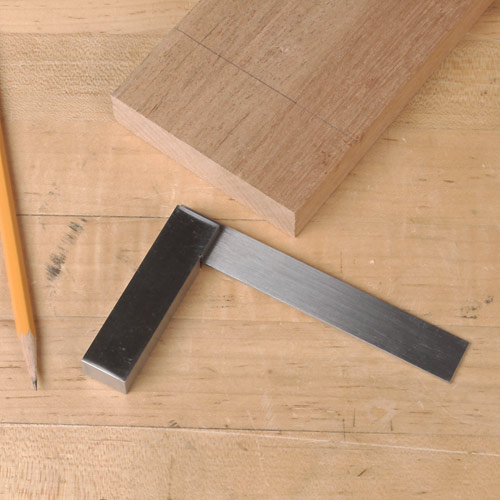
However, I prefer to use a “Combination Square” (see Figure 2). The Combination Square is sufficiently accurate, and has features not available on the Engineer Square.
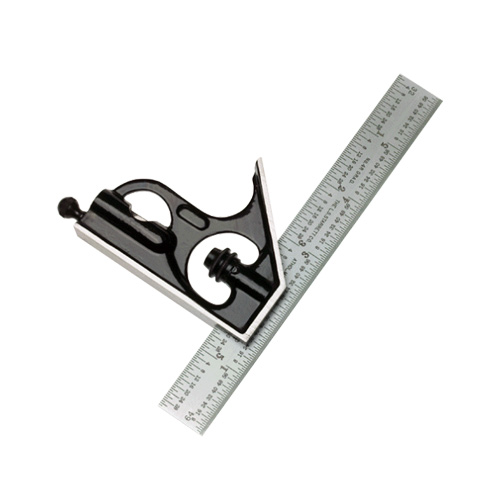
The Combination Square provides the following features:
- Draw 90 degree and 45 degree lines,
- Adjustable ruler position (allows use as a depth gauge and a drawing guide),
- Simple bubble level,
- Scribe tool – I use this to make an indent in the wood where I plan to drill. This minimizes drill bit “wander”.
Combination Squares come with 6 inch or 12 inch rules. For carpentry work, the 12 inch version is generally used, however, for pinewood derby use, the 6 inch version is much more handy.
Adjusting the Ruler Position
- Loosen the locking knob,
- Slide the ruler to the desired position,
- Tighten the locking knob.
Drawing a Line Perpendicular to the Block (see Figure 3)
- Ensure that at least 1-3/4 inches of the ruler is extending beyond the head of the square,
- Hold the head of the square tightly against the block at the desired position,
- Draw the perpendicular line.
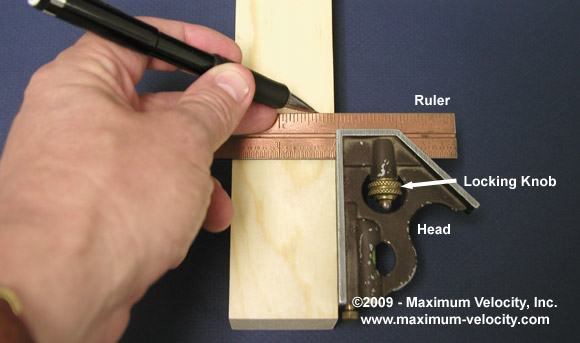
(User’s right hand not shown for clarity)
Drawing a Line Parallel to the Block (see Figure 4)
- Extend the ruler the desired amount beyond the head of the square (i.e., if you want a line 1/2 inch from the edge of the block, set the head at 1/2 inch),
- Hold the head of the square tightly against the block,
- Place the pencil at the end of the ruler, then
- Slide the head of the square along the block, keeping the pencil tight against the end of the ruler, and the head of the square tightly against the block.
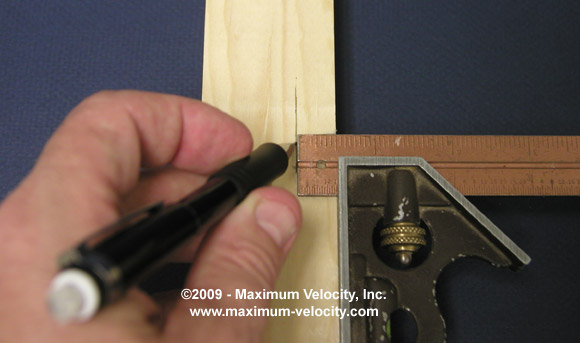
(User’s right hand not shown for clarity)
Pinewood Derby Car Showcase
Radio Controlled Propeller Car – Bill Klingler
This is my radio controlled propeller driven car. It is powered with a motor, a 7.2 volt battery and the receiver/speed control from a Losi Mini-T RC car. The joy comes from watching the scouts laugh and run along side the track as the car is zooming past. Since it is radio controlled it will also back up. Lots of Fun.
Corn Dog Propeller Car – Bruce Kempf
Every year after NASCAR season is over we have a party and a corn dog Derby race. We use a three lane pinewood derby track, pinewood derby car kits, etc. The only difference is racers have to use a corn dog with the car. This car was made from your Propeller Car Kit. I attached the corn dog to the propeller car with Velcro, so I could remove it for the race — although it blew away the field with the corn dog attached.
Q&A
For the last two years my son has had a CSB Kit and I was wondering what’s the best method for installing the axles? Last year I used a small hammer to install the axles but there must be another method that will not potentially damage the wheels or bend the axles. Also, what’s the difference between the Pro body Tool II model #5140 and model #5145 besides the drill bit size?
The only difference between the two tools (5140 and 5145) is the bit size.
Assuming that the kit you are referring to is the one in this photo:
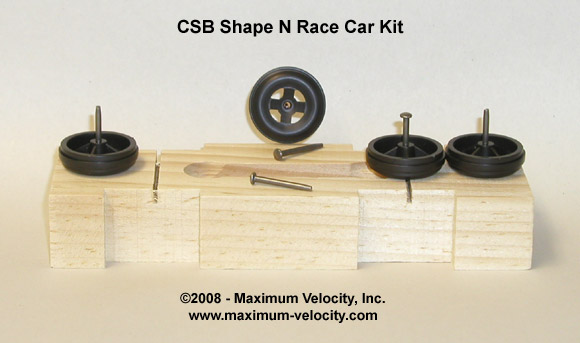
The tools would drill the pilot holes rather low in the slots (the CSB kit has very deep slots. The Pro-Body Jig does set the holes higher, so it would be better for the CSB kit.
How far is the car off the track when you use the Pro-Body Jig?
That would depend on the wheel diameter. But if you are using Cub Scout Speed wheels, which are 1.170 in OD, then the distance off the track would be pretty close to
1.17 / 2.0 (Wheel Radius)
minus
0.156 (axle hole offset from bottom of block)
minus
(.097-.087) / 2 (wheel slop = bore OD minus axle OD divided by 2
equals
0.424 inch (just over 27/64 inch)
Note that .375 (3/8 inch) is the typical clearance requirement.
My speed axles don’t fit in a #44 bit drilled hole. What bit do I need?
The speed axles are 0.087 in diameter. A #44 bit is .086. So the hole will be a bit tight (and you want them a bit tight so they have no slop and will stay in place.
What I suggest is that after drilling the holes, take a spare axle and insert it into a hole. Then remove it with a pair of pliers, and repeat for the other three holes. This will open up the holes, making it much easier to insert the real ones.
Also, if you plug the holes with round toothpicks while painting, the holes will stay free of paint. But if you do get paint in the holes, you can ream out the holes (by hand with a Pin Vise) with the #44 drill bit.
The next closest bit is a #43, which is .089. This hole size is just a little too big for the axles.
Want Answers?
Do you have a pinewood derby-related question? If so, e-mail us your question.We answer all questions by e-mail, but not every question will appear in the Q&A section of the newsletter.
Back Issues
Are you a new subscriber, or have you missed some of the previous newsletters? Don’t miss out; all of the issues for Volume 5 through Volume 17 are posted on our web site.
Newsletter Contributions
We welcome your contributions. If you would like to contribute an article, a web site review, a speed tip, or a pinewood derby memory, please e-mail us.
Subscription Information
The Pinewood Derby Times is a free e-newsletter focused on pinewood derby racing. It is published biweekly from October through March.
If you haven’t already done so, please forward this issue to your pinewood derby friends. But please don’t subscribe your friends. Let them decide for themselves. Thanks.
If this newsletter was forwarded to you, why not subscribe to receive this newsletter. There is no cost, and your e-mail address is safe, as we never sell or share our distribution list.
To subscribe, send a blank e-mail to
pi*********************@*******st.com
You will receive a confirmation e-mail. Reply to the confirmation e-mail and you will start receiving the Pinewood Derby Times with the next issue.
Randy Davis, Editor, Pinewood Derby Times
E-Mail: in**@**************ty.com
(C)2018, Maximum Velocity, Inc. All rights reserved. Please do not reprint or place this newsletter on your web site without explicit permission. However, if you like this newsletter we grant permission, and encourage you to e-mail it to a friend.
Maximum Velocity disclaims any personal loss or liability caused by utilization of any information presented in this newsletter.
The Pinewood Derby Times is not specific to, and is not affiliated with the Boy Scouts of America, YMCA, Awana, or any other organization.
(R)Maximum Velocity is a registered trademark of Maximum Velocity, Inc.
(R)Pinewood Derby is a registered trademarks of the Boys Scouts of America.
(R)Awana is a registered trademark of Awana Clubs International.
All other names are trademarks of their respective owners.

